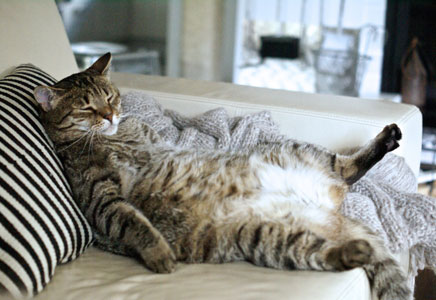"caring for cats"

Feline Obesity
Flabby Felines and Cuddly Kitties

By Samantha Taylor BVetMed(Hons) CertSAM DipECVIM-CA FRCVS
EBVS® European Veterinary Specialist in Small Animal Internal Medicine
RCVS Recognised Specialist in Feline Medicine
Associate of the American College of Veterinary Internal Medicine
Veterinary Specialist Lead at The International Society of Feline Medicine (ISFM)
Honorary Lecturer in Small Animal Medicine at the University of Surrey
We know the human population is getting heavier, and that weight gain can have impacts on our health. Did you know that the same is true for cats? Feline obesity is an increasing problem and veterinary teams are seeing more and more heavy cats. Let’s discuss why this is an important problem to address and how we can help these flabby felines.

Just being a little overweight still has health impacts.
Why worry about obesity?
It can seem funny to see a large cat wobbling around, and there are many internet videos of amusing overweight felines, but really it isn’t funny. Obesity (defined as being 20% or more over a healthy weight) is actually considered a chronic (long-term) disease as it has such big impacts on a cat’s health. Being a heavier than average kitty can lead to the following problems:
- Diabetes mellitus: overweight cats are more likely to develop this condition
- Lower urinary tract disease: disease of the bladder are more common in fat cats, and at its most severe that includes life-threatening blockages
- Osteoarthritis: being overweight may not cause arthritis directly, but it certainly makes it worse and painful joints are no joke for our normally athletic cats
- Constipation: an unpleasant consequence due to sluggish intestines
Being overweight can also reduce a cat’s mobility, meaning they play less and interact less with other pets and family members. Moving less then can perpetuate the weight gain. Additionally, grooming behaviour can be reduced in our chubby kitties, and we know cats are fastidious about keeping clean. In severe cases a cat’s hair can become matted and skin sore. We also know that overweight cats are at higher risk under an anaesthetic, and can react to medications differently, all negatives to the extra fat. In fact many other health problems have been linked to obesity in cats, including breathing issues, intestinal problems and even liver diseases.
How do I know if my cat is overweight or obese?
In many cases your cat’s weight might be mentioned at a health check at the veterinary clinic, and your vet or nurse/technician are well placed to monitor your cat. However, you can also weigh your cat at home, as low cost ‘baby’ scales work well for cats. Additionally, owners and caregivers can check a cat’s body condition score using a scale like the one below:

If your cat scores too high, have a chat with your vet! In general, measuring a cat’s waist is not a useful way of assessing their body condition, but it can help when monitoring weight loss. Do note that cats can have a ‘belly flap’ or ‘primordial pouch’ whatever their body condition (designed to protect when fighting, and expand after eating etc), but it can become larger and lower if combined with being overweight.
What can we do about it?
The answer is lots, but we must always remember that restricting food severely can result in severe health problems (fatty liver) so always take advice from your veterinary team if you think your cat is overweight before launching into a diet. There are also some checks that may need to be done before embarking on a feline health-kick. We also know, just like us humans, a weight-loss programme works best with support which your veterinary team can provide. In general, there are some tips that might help your chubby feline friend slimming down:
- Get them moving! Most cats will love chasing a ‘fishing’ toy or chasing a ball and anything that increases activity can help. For older cats have a word with your vet as some need a little help from painkillers to get moving if joints are sore

- Cut down the treats. Much as we might love offering something from our plate or a few treats here and there, it can pack on the pounds so leave them out
- Puzzle feeding. Not heard of it? It is a way of encouraging a cat to work a little for their food and also helps keep them mentally active, have a look here: http://foodpuzzlesforcats.com/ for shop-bought or home-made puzzles
- Discuss a diet change with your vet. Sometimes a special diet can help the hunger pangs and ensure your cat is getting much needed vitamins
- Weigh the food. How much do you feed? Is it a scoop here and tin there? Get advice from your veterinary team on how much you should actually be feeding, and get the scales out, it is easy to add a few more biscuits by mistake.
There is hope!
We know that by thinking a little harder about how much and what we feed, and getting cats moving that they can lose weight. Don’t become disheartened if loss is slow – it needs to be healthy. We also know that even some weight loss can improve a cat’s health. So, dust off the scales, stop the treats, and get your cat back to fighting fit!
August 2023Feline Ailments
"There is no need to teach cats how to have fun, since they are blessed with an inherent talent in this art"
James Mason

 menu
menu